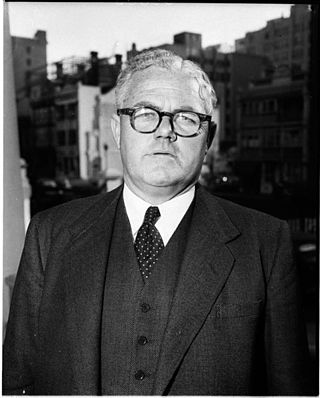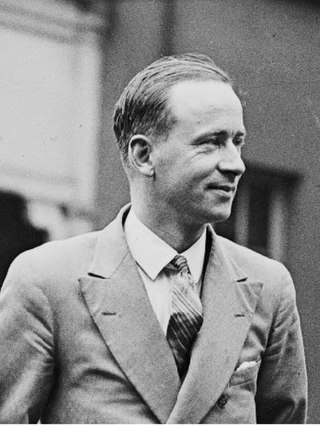
John Christian Watson was an Australian politician who was the third prime minister of Australia, in office from 27 April to 18 August 1904. He was the inaugural federal leader of the Australian Labor Party (ALP) from 1901 to 1907 and was the first member of the party to serve as prime minister.

Francis Michael Forde was an Australian politician who served as the 15th prime minister of Australia from 6 to 13 July 1945. He was deputy leader of the Australian Labor Party from 1932 to 1946 and served as prime minister in a caretaker capacity following the death of John Curtin. He is the shortest-serving prime minister in Australia's history.

The Democratic Labor Party (DLP) was an Australian political party. The party came into existence following the 1955 ALP split as the Australian Labor Party (Anti-Communist), and was renamed the Democratic Labor Party in 1957. In 1962, the Queensland Labor Party, a breakaway party of the Queensland branch of the Australian Labor Party, became the Queensland branch of the DLP.

The Communist Party of Australia (CPA), known as the Australian Communist Party (ACP) from 1944 to 1951, was an Australian communist party founded in 1920. The party existed until roughly 1991, with its membership and influence having been in a steady decline since its peak in 1945. Like most communist parties in the West, the party was heavily involved in the labour movement and the trade unions. Its membership, popularity and influence grew significantly during most of the interwar period before reaching its climax in 1945, where the party achieved a membership of slightly above 22,000 members. Although the party did not achieve a federal MP, Fred Paterson was elected to the Parliament of Queensland at the 1944 state election. He won re-election in 1947 before the seat was abolished. The party also held office in over a dozen local government areas across New South Wales and Queensland.
The Labor Left, also known as the Progressive Left or Socialist Left, is a political faction of the Australian Labor Party (ALP). It competes with the more economically liberal Labor Right faction.
The Liberal Party was a parliamentary party in Australian federal politics between 1909 and 1917. The party was founded under Alfred Deakin's leadership as a merger of the Protectionist Party and Anti-Socialist Party, an event known as the Fusion.

Albert Redvers George Hawke was an Australian politician who was the premier of Western Australia from 23 February 1953 to 2 April 1959. He represented the Labor Party.
The Industrial Groups were groups formed by the Australian Labor Party (ALP) in the late 1940s, by Catholic ALP members aligned with B. A. Santamaria's "Movement" within the ALP from 1944, to combat alleged Communist Party infiltration in the trade unions.

Joseph Herbert Gander was an Australian politician. He was a member of the Australian House of Representatives from 1931 to 1940, representing the Sydney-based seat of Reid for the first Lang Labor (1931–1936), the Australian Labor Party (1936–1940) and the second Lang Labor (1940).

Arthur Edward Greenup was a trade unionist and politician in New South Wales, Australia.
The New South Wales Labor Party, officially known as the Australian Labor Party (New South Wales Branch) and commonly referred to simply as NSW Labor, is the New South Wales branch of the Australian Labor Party (ALP). The branch is the current ruling party in the state of New South Wales and is led by Chris Minns, who has served concurrently as premier of New South Wales since 2023.

Philip Henry (Pat) Morton was an Australian businessman and politician. Born in Lismore in Northern New South Wales to a prominent political family and educated at Lismore High School, Morton left school at fourteen to be employed in a legal firm, before branching out into various businesses. Moving to Sydney, Morton first entered politics in 1944 as an Alderman on Mosman Municipal Council, rising to be Mayor in 1946. Morton then entered the New South Wales Legislative Assembly on 3 May 1947, representing the Electoral district of Mosman for the Liberal Party.

Major Clarence Edward Martin was an Australian politician and a member of the New South Wales Legislative Assembly from 1930 until 1932 and from 1939 until his death in 1953. He was variously a member of the Australian Labor Party (NSW), the Industrial Labor Party and the Labor Party (ALP). He was the Attorney General of New South Wales from 1941 until 1953 and also held the position of Minister for Transport for six months prior to his death.

The 1953 New South Wales state election was held on 14 February 1953. It was conducted in single member constituencies with compulsory preferential voting and was held on boundaries created at a 1952 redistribution. The election was for all of the 94 seats in the Legislative Assembly.
Francis Hill was an Australian politician and a member of the New South Wales Legislative Assembly between 1941 and his death. He was a member of the Labor Party.

The 1956 New South Wales state election was held on 3 March 1956. It was conducted in single member constituencies with compulsory preferential voting and was held on boundaries created at a 1952 redistribution. The election was for all of the 94 seats in the Legislative Assembly.
The Australian Labor Party split of 1955 was a split within the Australian Labor Party along ethnocultural lines and about the position towards communism. Key players in the split were the federal opposition leader H. V. "Doc" Evatt and B. A. Santamaria, the dominant force behind the "Catholic Social Studies Movement" or "the Movement".
The history of the Australian Labor Party has its origins in the Labour parties founded in the 1890s in the Australian colonies prior to federation. Labor tradition ascribes the founding of Queensland Labour to a meeting of striking pastoral workers under a ghost gum tree in Barcaldine, Queensland in 1891. The Balmain, New South Wales branch of the party claims to be the oldest in Australia. Labour as a parliamentary party dates from 1891 in New South Wales and South Australia, 1893 in Queensland, and later in the other colonies.
The Tasmanian Labor Party, officially known as the Australian Labor Party (Tasmanian Branch) and commonly referred to simply as Tasmanian Labor, is the Tasmanian branch of the Australian Labor Party. It has been one of the most successful state Labor parties in Australia in terms of electoral success.

The 2023 New South Wales state election was held on 25 March 2023 to elect the 58th Parliament of New South Wales, including all 93 seats in the Legislative Assembly and 21 of the 42 seats in the Legislative Council. The election was conducted by the New South Wales Electoral Commission (NSWEC).










